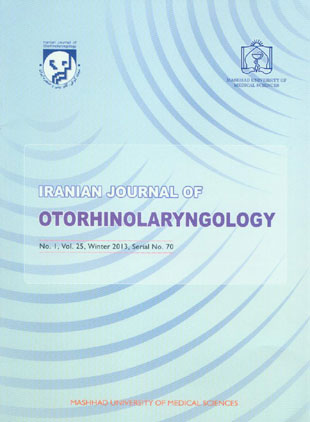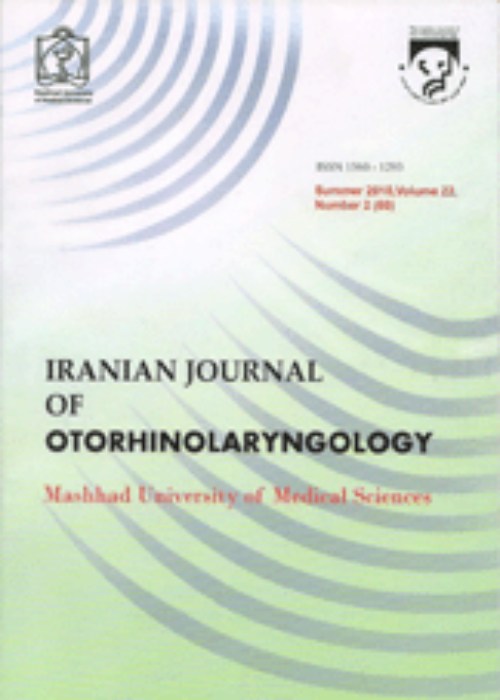فهرست مطالب

Iranian Journal of Otorhinolaryngology
Volume:25 Issue: 1, Winter 2013
- تاریخ انتشار: 1391/09/14
- تعداد عناوین: 10
-
-
Pages 7-10IntroductionAdequate pain control is an important consideration in the post-surgical management of patients. Local nerve blockade added to general anesthesia can provide excellent pain control during and after most nasal surgical procedures. The aim of this study was to determine the combined effect of local anesthetic drugs with corticosteroids in nasal surgery.Materials And MethodsIn this double-blind clinical study, 60 patients who underwent different nasal surgical procedures were matched and divided into two equal groups. Bilateral local nerve blockade was used in both groups. Bupivacaine or bupivacaine plus dexamethasone was administered by injection (groups B and B+D, respectively). Postoperative visual analog scale (VAS) pain values and the need for oral/intramuscular analgesic treatment in the first 24 h were recorded in all patients.ResultsThirty-eight male (63.3%) and 22 female (36.7%) patients were included in this study, with a mean age of 28.3 ± 8.2 years. At 1, 2, 4, 6, and 12 h post surgery, VAS pain values were significantly lower in the B+D group than in the B group. The analgesic requirement was significantly lower in the B+D group compared with the B group. No relevant complications were seen during surgery or postoperative hospitalization.ConclusionThis study demonstrates the positive effect of a combination of a dexamethasone with a bupivacaine in reducing pain and the need for analgesic drugs after different nasal surgeries. No acute or short-term post-surgical complications were observed in this study.Keywords: Analgesics, Anesthesia, Complications, Nasal Surgical Procedures, Pain
-
Pages 11-15IntroductionDisorders of the nose and paranasal sinuses are among the most common chronic illnesses. Although considerable progress has been made in the medical and surgical control of these diseases, a large number of questions relating to the diagnosis, evaluation, and treatment of these conditions remain unanswered. The aim of the present study was to evaluate differences in the frequency of symptoms and disease severity in patients with nasal septal deviation (NSD) compared with chronic rhinosinusitis (CRS).Materials And MethodsA total of 156 patients, divided into NSD and CRS groups, were studied in relation to symptoms and disease severity. Patients were selected from those referred to the Ear, Nose, and Throat (ENT) Wards of the Imam Reza and Ghaem Hospitals, who had not responded to a variety of treatments. Depending on the type of disease, patients were candidates for either septoplasty or endoscopic sinus surgery. The Rhinosinusitis Symptom Inventory was administered to measure the severity of symptoms, with scores assigned based on the answers given by patients (Likert scale). Scores were compared between the CRS and NSD groups.ResultsA total of 156 patients (78 with NDS and 78 with CRS) entered the study in overall sinonasal symptoms were more prevalent in CRS group. Nasal congestion, runny nose, earache, toothache, and smelling disorder were significantly more common in the CRS group (P<0.001); while there were no significant differences in symptoms such as facial pressure, fever, or headache between the two groups (P>0.05).ConclusionPatients with CRS manifested statistically significantly greater sinonasal symptom scores than patients with NSD.Keywords: Chronic rhinosinusitis, Septal deviation, Symptoms of sinonasal disease
-
Pages 17-22IntroductionTo describe a modified technique for submental intubation in severely traumatized maxillofacial patients and to evaluate complications arising from the procedure.Materials And MethodsSubmental intubation was performed in twelve patients with maxillofacial trauma, from 2007-2012, which were operated under general anesthesia for treatment of facial fractures.ResultsThe patients ranged in age from 14 to 39 years. No complications due to submental intubation, such as infection, hypertrophic scarring, lingual nerve injury, hematoma, bleeding, ranula formation, or orocutaneous fistula, were observed following submental intubation.ConclusionSubmental intubation is a very useful technique in the management of maxillofacial trauma patients, with a low complication rate.Keywords: Intubation, Jaw fracture, Submental
-
Pages 23-28IntroductionThe aim of this study was to evaluate the efficacy of combined intratympanic and systemic steroid therapy compared with systemic steroid therapy alone in idiopathic sudden sensorineural hearing loss (ISSNHL) patients with poor prognostic factors.Materials And MethodsSeventy-seven patients with sudden sensorineural hearing loss (SSNHL) who had at least one poor prognostic factor (age greater than 40 years, hearing loss more than 70 db, or greater than a 2-week delay between the onset of hearing loss and initiation of therapy) were included in this study. Patients were randomized to the intervention group (combined intratympanic and systemic steroid therapy) or the control group (systemic steroid therapy alone). All patients received oral treatment with systemic prednisolone (1 mg/kg/day for 10 days), acyclovir (2 g/day for 10 days, divided into four doses), triamterene H (daily), and omeprazole (daily, during steroid treatment), and were advised to follow a low salt diet. The intervention group also received intratympanic dexamethasone injections (0.4 ml of 4 mg/ml dexamethasone) two times a week for two consecutive weeks (four injections in total). A significant hearing improvement was defined as at least a 15-db decrease in pure tone average (PTA).ResultsAmong all participants, 44 patients (57.14%) showed significant improvement in hearing evaluation. More patients showed hearing improvement in the intervention group than in the control group (27 patients (75%) versus 17 patients (41.4%), respectively; P = 0.001).ConclusionThe combination of intratympanic dexamethasone and systemic prednisolone is more effective than systemic prednisolone alone in the treatment of poor-prognosis SSNHL.Keywords: Intratympanic Dexamethasone, Sudden deafness, Sudden hearing loss
-
Pages 29-35IntroductionThe phenomenon of neglected foreign bodies is a significant cause of morbidity in soft tissue injuries and may present to dermatologists as delayed wound healing, localized cellulitis and inflammation, abscess formation, or foreign body sensation. Localization and removal of neglected soft tissue foreign bodies (STFBs) is complex due to possible inflammation, indurations, granulated tissue, and fibrotic scar. This paper describes a simple method for the quick localization and (surgical) removal of neglected STFBs using two 23-gauge needles without ultrasonographic or fluoroscopic guidance.Materials And MethodsA technique based on the use of two 23-gauge needles was used in 41 neglected STFBs in order to achieve proper localization and fixation of foreign bodies during surgery.ResultsSurgical removal was successful in 38 of 41 neglected STFBs (ranging from 2–13mm in diameter).ConclusionThe cross-needle-guided technique is an office-based procedure that allows the successful surgical removal of STFBs using minimal soft tissue exploration and dissection via proper localization, fixation, and propulsion of the foreign body toward the surface of the skin.Keywords: Foreign body, Soft tissue, Surgery
-
Pages 37-40IntroductionSleep disorder caused by adenotonsillar hypertrophy has been implicated as a cause of primary and secondary nocturnal enuresis in children. This study was conducted to investigate the effect of adenotonsillectomy on enuresis in children with adenotonsillar hypertrophy.Materials And MethodsThis prospective cohort study was conducted in Hamadan City in Western Iran, from April 2010 to December 2011. Ninety-seven children aged 3 to 12 years with adenotonsillar hypertrophy who were admitted to Besat Hospital for adenotonsillectomy were evaluated. The primary outcome was the number of incidents of bedwetting (nocturnal enuresis) post-operation compared with pre-operation. Patients were followed-up for 3 months. Data were collected using a questionnaire regarding number of bedwetting incidents, type of enuresis (primary or secondary), and family history of enuresis, as well as results of urine analysis.ResultsOf 420 children admitted for adenotonsillectomy, 97 had a positive history of preoperative enuresis, including 42 girls and 55 boys, with mean age of 48 months. The parents of 84 (86.6%) children agreed to participate in the study. Three months after adenotonsillectomy, enuresis had resolved completely in 51 (60.7%) children and had shown relative improvement in 22 (26.2%) children. Enuresis had not improved in the remaining 11 (13.1%) children (P<0.001).ConclusionThe results of this study indicate that adenotonsillectomy can improve enuresis in the majority of children with adenotonsillar hypertrophy. However, further evidence based on large multi-center randomized clinical trials is required to confirm these results.Keywords: Adenoids, Cohort studies, Enuresis, Hypertrophy, Iran
-
Pages 41-48IntroductionThe family of each hearing-impaired child has its own cultural, social, educational, and financial background, and its own special needs. The objectives of our study were to explore the information and support needs of parents of children with severe-to-profound hearing impairment and to investigate the effects of the parents’ level of education and economic status on the score attained in the parents’-needs questionnaire.Materials And MethodsFifty-one parents of children with severe-to-profound hearing loss (53% girls, 47% boys; mean age 47.96 months) who used the Auditory-Verbal Therapy approach were asked to complete the parents’-needs questionnaire. The questionnaire included demographic information and hearing-loss history and covered six domains which evaluated the information or support needs of parents. Parental needs with regard to different domains were evaluated separately in all participants.ResultsStatistical analysis indicated that there was a significant decrease in the score attained in the parents’-needs questionnaire with increasing level of education of the child’s parents (P<0.0001). Furthermore, the questionnaire score decreased as the parents’ economic status increased (P<0.0001).ConclusionThe results of our study indicate that most parents of hearing-impaired children need adequate and appropriate information in all domains, and these findings support the positive effect of creating an appropriate educational environment by considering individualized needs. Furthermore, parents’ levels of education and economic status have a significant effect on their parents’ needs.Keywords: Auditory, verbal therapy, Children, Economic status, Educational level, Parents, Needs
-
Pages 49-52IntroductionAmyloidosis comprises a heterogeneous group of disorders characterized by the deposition of amyloid protein in various organs of the body. The larynx is one of the rarer sites where amyloidosis occurs. Case Report: A 36-year-old man presented with a two-year history of hoarseness of voice. He had a positive history of smoking, but no history of long-term consumption of alcohol. Physical examination revealed a pinkish mass about 1.5 × 1.5 cm in size on his left False Vocal Cord (FVC) extending to the left arytenoid, which resulted in asymmetry of the posterior larynx. He also had a chronic perforation of the right tympanic membrane with a conductive hearing loss consisting of a 50 dB gap in pure tune audiometry. The FVC mass was excised with a CO2 laser and on follow-up his voice got much better, but the hoarseness was not fully resolved.ConclusionAmyloidosis of the larynx is a rare, usually benign process but the area is the most common site for isolated amyloid deposits to occur in the head and neck.Keywords: Amyloidosis, Hoarseness, Larynx
-
Pages 53-56IntroductionSpontaneous Perforation of the nasal septum is an uncommon condition. Nasal inhalation of substances such as cocaine has long been linked to this Perforation. Case Report: This report describes the case of a 46-year-old woman who was addicted to methamphetamine and who presented with perforation of the nasal septum.This is the first reported case of nasal septal necrosis linked to nasal inhalation of methamphetamine.ConclusionsPatient history and assurance regardingillegal drug consumption and abuse is a key point for fast and accurate diagnosis. The pathophysiology of drug-induced sinunasal disease and a review of the literature are also presented.Keywords: Ehsan Khadivi, Mehdi Bakhshaee, Masoud Naseri Sadr, Fereshteh Esmatinia
-
Page 57Nasal anatomy and shape is race-related. Caucasians (leptorrhine) have generally high dorsum and projected tip، while The Asian nose (platyrrhine، mesorrhine) is known by thick skin with low، wide and flat nasal bridge with short nasal bones، and a broad، bulbous، thick-skinned and less projected nasal tip


